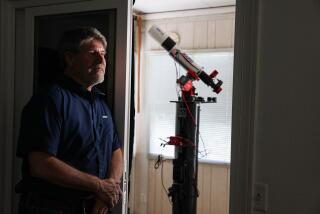Web opens new horizons for astronomers
Amateur astronomer William Bianco doesn’t huddle over a backyard telescope to hunt for undiscovered planets. He logs onto his computer.
Bianco, who was mesmerized by the intricacies of the universe as a young boy, is part of a growing online community that sifts through mountains of data collected by professional scientists in search of other worlds.
While Bianco has yet to make a landmark discovery, he savors the rush of being on the cutting edge of research.
Never before have amateur astronomers had so much unfettered access to celestial data once available only to scientists with huge telescopes. In the latest frontier of astronomy, professionals are increasingly enlisting the aid of novices with personal computers to help pore through images and data -- all in pursuit of the next great breakthrough.
“We’re in the golden age of astronomy,” said Bianco, who has a day job as a political science professor at Indiana University.
Thanks to technology, novices are effectively turning from lonely sky-watchers to research assistants. Even before the rise of virtual astronomy, amateurs did such things as track asteroids, detect supernova explosions and watch for new comets.
In 1995, neophyte stargazer Thomas Bopp gained fame for co-discovering what would be known as Comet Hale-Bopp. Two years ago, in what was billed as the first such find by an amateur in 65 years, Jay McNeil of Kentucky took a picture of a new nebula -- an illuminated cloud of gas and dust lighted by what is believed to be a newborn star.
Since the late 1990s, virtual astronomy has boomed. One of the earliest online citizen scientist projects was SETI@home, which distributed software that created a virtual supercomputer by harnessing idle, Web-connected PCs to search for alien radio transmissions.
While the SETI project hums in the background as a screen saver, the newer efforts require more human thought.
Bianco belongs to an Internet project called Systemic, which boasts 750 amateur planet hunters. Astronomers have already discovered more than 200 planets in far-off solar systems using traditional methods, yet there are likely more out there.
Participants download software and rifle through data that measure the tiny gravitational wobble in a star’s motions in searching for planets that orbit stars other than our sun. Users also try to decode simulated data of planetary systems invented by the project managers -- a task that will help the professionals better understand real extrasolar planets.
To participate, users select a star -- real or simulated -- and adjust other variables such as a planet’s mass and orbital period by moving a slider back and forth on the screen. The goal is to design a planetary system that best fits the data and then publish the answer online.
So far, online users have pinpointed hundreds of potential candidates, but only five might actually be real, said Systemic project head Greg Laughlin, an astronomer at UC Santa Cruz.
“It’s not an aimless game,” he said.
Although the Systemic website provides the search tools, it doesn’t promote any of the discoveries, Laughlin said. Amateurs who want to publicize their find need to look for another outlet, such as a scientific journal, to get credit.
Laughlin is no stranger to Web-based astronomy. He helped start another project in which amateurs point their telescopes at potential extrasolar planetary systems and look at dimming starlight to learn about a planet’s size and composition. Unlike Systemic, users have to buy expensive equipment -- including telescopes and cameras -- to participate.
Before Internet-based astronomy, it took a long time for novices to report their discoveries. High-speed, always-on Internet access has blurred the line between the professionals and amateurs, said Terry Mann, president of the Astronomical League, made up of more than 240 U.S. amateur astronomy clubs.
Last year, Mann signed up to analyze a repository of online images of the first-ever microscopic grains of stardust brought back to Earth by a NASA spacecraft.
The work is painstaking. Mann and her fellow 25,000 volunteers eye hundreds of thousands of digital images in search of minuscule carrot-shaped trails left by the capture of stardust, believed to be the leftovers from stellar explosions.
Mann has submitted 40 possible examples of stardust in the images. If correct, amateurs can get their names published in scientific papers written by researchers at UC Berkeley, which manages the Stardust@home project. “Amateurs can do real science. We can actually help.”
Andrew Westphal, associate director of the Space Sciences Laboratory at Berkeley, praised amateurs -- it would probably take his lifetime to find all the dust sprinklings, he said.
“It’s stunning how good they are. I think they’re better at this than we are,” Westphal said.






